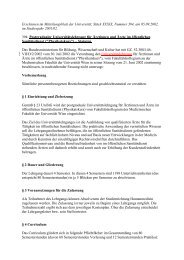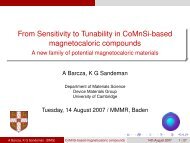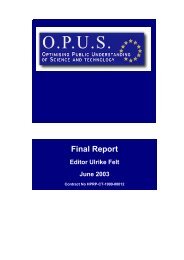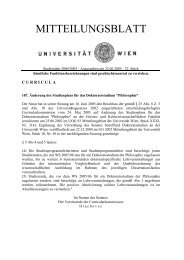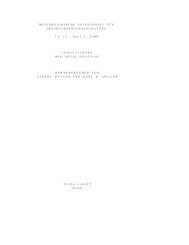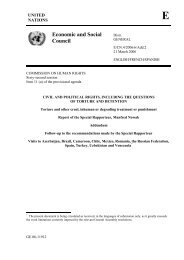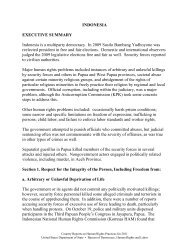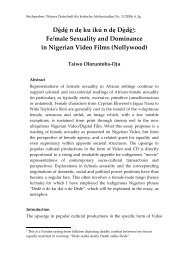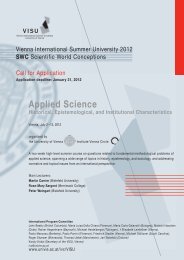(Stand: 25. Juli 2007) ANDERSON, Michael Alan ... - Universität Wien
(Stand: 25. Juli 2007) ANDERSON, Michael Alan ... - Universität Wien
(Stand: 25. Juli 2007) ANDERSON, Michael Alan ... - Universität Wien
Create successful ePaper yourself
Turn your PDF publications into a flip-book with our unique Google optimized e-Paper software.
MEDIEVAL & RENAISSANCE MUSIC CONFERENCE <strong>2007</strong> – WIEN, 7.-11. AUGUST ABSTRACTS<br />
the two. In fact, Le Brung responded to Josquin’s N’esse pas not only on the level of prosody<br />
but also on that of compositional strategy and musical detail. The negative, pessimistic<br />
tone of N’esse pas is confronted with an affirmative, optimistic poem. By changing the<br />
order of the model’s words, the response alters their semantic potential and reverses the<br />
tone of the original setting’s content. Le Brung’s musical treatment not only closely follows<br />
the compositional strategies employed by Josquin but also reflects in musical terms<br />
the reversal of tone effected in the poetic response. Le Brung’s compositional process<br />
sheds light on what a contemporary composer read as important in Josquin’s setting and<br />
allows us, in turn, to interpret Josquin’s chanson with greater depth and clarity.<br />
The macroscopic conception of Le Brung’s response provides a glimpse into the subtle<br />
ways by which contemporary composers demonstrated their prowess in addressing the<br />
poetic and musical challenges posed by the model settings.<br />
� �<br />
KREYSZIG, Walter (University of Saskatchewan, Saskatoon, Canada)<br />
Sixteenth-Century Music Theoretical Discourse in Manuscript Vienna, ÖNB Codex<br />
Ser. Nov. 12745“: The “systema teleion“ in Franchino Gaffurio’s De harmonia<br />
musicorum instrumentorum opus as Commentary Upon Commentary<br />
Samstag/Saturday, 11.8., 10.15 Uhr, KuGe, SR 3<br />
While Renaissance commentators working in the realm of various humanities generally<br />
focus their deliberations on single volumes, commentators in the disciplina musicae usually<br />
take on a more comprehensive view, often embracing a considerable hiatus, spanning<br />
from Antiquity to the actual date of the commentary itself, so as to provide a more or less<br />
comprehensive account centered squarely on historiography, at the center of which lies<br />
the question concerning the origin of music. The trilogy of Franchino Gaffurio (1451–1522),<br />
comprising the Theorica musice (Milan, 1492), the Practica musicae (Milan, 1496) and the De<br />
harmonia musicorum instrumentorum opus (Milan, 1518), represents a case in point. While the<br />
Theorica musice focuses on the musica speculativa, including an extensive commentary on<br />
the systema teleion and the Guidonain system, and the Practica musicae embraces the practica<br />
compositionis, the De harmonia underscores a return to the systema teleion first discussed in<br />
the Theorica musice as well as in its predecessor, the Theoricum opus musice discipline<br />
(Naples, 1480), the first printed volume in music theory in the history of Western music.<br />
The revisiting of an already fullfledged commentary on the Greek tonality and Western<br />
modality in the De harmonia is amply justified on two levels, on the one hand in Gaffurio’s<br />
self-imposed comparison of the Greek tonoi and the Western modi – a comparison which is<br />
rooted in the similar terminology accorded to both scalar systems, yet with vastly different<br />
meaning assigned to the respective systems of scales in the Greek and Latin traditions<br />
– which accounts for his confusion of the terms octave species, modes, and tonoi in<br />
the glossing of the De institutione musica of Anicius Manlius Severinus Boethius in Book 5<br />
of the Theorica musice and the ultimate clarification in the De harmonia, and on the other<br />
hand, in Gaffurio’s reconciliation of two important treatises accessible to him in recent<br />
Latin translations, namely, Giorgio Valla’s translation of Cleonides Introduction to Harmonics<br />
(1497) and Nicolo Leoniceno’s translation of Ptolemys’ Harmonics (1499), with both of<br />
these documents providing a new perspective on a topic central to sixteenth-century<br />
commentaries on music. In his commentary on the commentary, as elegantly captured in<br />
- 49 -




